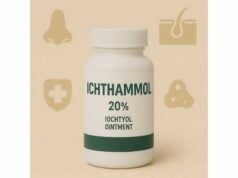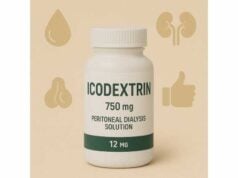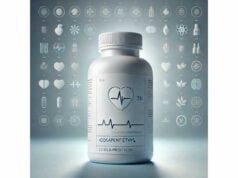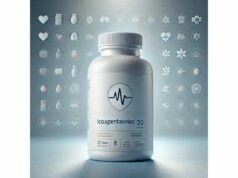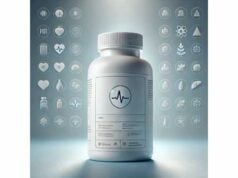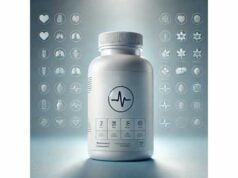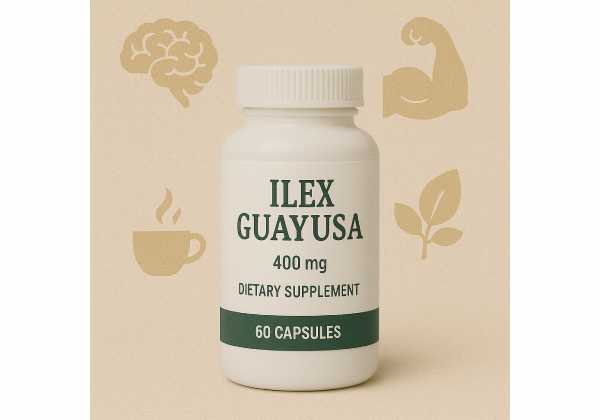
Ilex guayusa (pronounced “gwhy-OO-sah”) is an Amazonian holly traditionally brewed as a bright, earthy tea. It naturally contains caffeine along with chlorogenic acids, quercetin derivatives, and other polyphenols that contribute antioxidant activity. Many people use guayusa as a gentler, steady energy source for morning focus, pre-work sessions, or long workdays. Early research suggests guayusa extracts may sharpen reaction time and mood acutely, while leaf chemistry and brew method influence antioxidant yield. As with all caffeinated botanicals, it’s important to match your intake to your tolerance and circumstances—especially around sleep, pregnancy, and certain medications. This guide translates the science and tradition into practical steps: how guayusa works, who it may help, how to prepare it for consistent results, the right daily amounts, and the side effects to watch for so you can benefit confidently.
Quick Overview
- Supports alertness and cognitive performance; early data show faster psychomotor speed with standardized extract.
- Provides dietary polyphenols (e.g., chlorogenic acids) that add antioxidant activity to brewed tea.
- Typical tea dose: 1.5–3 g dried leaf per 250 ml, 1–3 cups/day; standardized extract: 600–1,200 mg/day.
- Caffeine-related effects (jitters, elevated blood pressure) are possible; avoid near bedtime.
- Avoid or limit if pregnant, sensitive to caffeine, or advised to restrict stimulants.
Table of Contents
- What is Ilex guayusa and how does it work?
- Benefits you can expect from guayusa
- How to use and dose guayusa for best results
- What changes potency: leaf, processing, and brewing
- Common mistakes and key interactions to avoid
- Safety, side effects, and who should avoid it
- Evidence at a glance and research gaps
What is Ilex guayusa and how does it work?
Ilex guayusa is a broadleaf evergreen holly native to the upper Amazon (especially Ecuador) whose leaves are dried and brewed like tea. In the cup, guayusa delivers a clean, grassy-to-malty flavor, light astringency, and a naturally occurring combination of caffeine and plant polyphenols. The synergy is what many users notice: the stimulant effect from caffeine paired with a smoother sensory profile owing to moderate bitterness and polyphenol balance. Unlike coffee, guayusa is usually lower in acidity and has a different matrix of chlorogenic acids and flavonols, which can change mouthfeel and perceived smoothness.
From a functional standpoint, caffeine blocks adenosine receptors in the brain, reducing perceived fatigue and increasing vigilance. In acute settings, standardized guayusa extracts have improved metrics like psychomotor speed and self-reported energy in healthy adults. Those effects are consistent with a caffeine-containing botanical, but the exact “feel” can vary with brew strength, extraction temperature, and leaf age. Alongside caffeine, guayusa contains chlorogenic acids (notably 5-CQA) and flavonols such as quercetin glycosides; these compounds contribute antioxidant capacity in chemical assays and may influence how you experience the beverage—especially when you brew longer or hotter, which extracts more polyphenols and bitterness.
Chemically, leaf composition changes as the plant matures. Younger leaves often show higher phenolic content and stronger antioxidant measurements than older leaves. Processing also matters: blanched leaves may retain more polyphenols than fermented styles, while advanced decaffeination or encapsulation techniques can alter the ratio of caffeine to antioxidants dramatically, creating lower-caffeine preparations for those seeking the polyphenols without as much stimulation.
Guayusa is not a cure-all, but for many it serves as a flexible daily beverage: lighter than coffee, more stimulating than most herbal tisanes, and easier to personalize. That makes it appealing for people who want sustainable morning focus, pre-exercise alertness, or a midday lift with a familiar brewing ritual. Because the primary active is caffeine, responsible use is essential—titrating your dose, minding the clock, and aligning intake with your sleep and sensitivity.
Benefits you can expect from guayusa
Steady alertness and task focus. The most consistent, near-term benefit of guayusa is heightened alertness. In a randomized, double-blind, crossover study using standardized guayusa extract (600–1,200 mg), participants improved psychomotor speed and reported higher perceived energy. Those results map onto caffeine’s well-known effects on vigilance and reaction time. For day-to-day use, many people find guayusa’s stimulation “cleaner” than coffee—likely a sensory impression influenced by lower acidity and a different phenolic fingerprint—which can help with sustained, lower-jitter productivity when brewed thoughtfully.
Pre-work or study boost. Acutely, caffeine doses around 1–3 mg/kg body weight can aid reaction time and perceived exertion. A typical 250 ml cup of guayusa brewed from 2 g leaf often lands in the ~30–60 mg caffeine range (the exact number depends on leaf and brew). One to two cups 30–60 minutes pre-activity can provide a modest lift without the heaviness some people experience with espresso.
Antioxidant contribution to the diet. Guayusa leaves contain chlorogenic acids, quercetin glycosides, and carotenoids (e.g., lutein). In laboratory assays (DPPH, ORAC), guayusa extracts show meaningful antioxidant capacity. While in-vitro data do not automatically translate to clinical endpoints, brewed guayusa can contribute to overall dietary polyphenol intake. If you’re already drinking tea or coffee for their polyphenols, guayusa is a credible alternative within a rotating routine.
Gentler sensory profile. Processing choices can preserve phenolics while moderating bitterness. Blanching tends to retain polyphenols with a lighter flavor than fully fermented leaves, which often lose bioactives and taste flatter. For people who find black tea harsh or coffee too acidic, a well-brewed guayusa can offer an enjoyable middle ground—especially with shorter steeps that emphasize brightness over astringency.
Who is most likely to notice benefits?
- Individuals sensitive to coffee’s acidity but seeking caffeine.
- Early-morning workers or students who prefer a tea-like routine.
- Endurance and skill athletes wanting a small, predictable caffeine dose.
- People building a polyphenol-rich beverage rotation without heavy tannins.
What guayusa is not. It is not approved to treat disease, replace medication, or serve as a stand-alone antioxidant therapy. Evidence in humans is emerging and focuses on acute performance and mood; long-term outcomes (e.g., metabolic health) have not been established. Expectations grounded in caffeine physiology—alertness, reaction time, mood—are appropriate; claims beyond that remain preliminary.
How to use and dose guayusa for best results
Tea preparation (daily use). Start with 1.5–3 g dried guayusa leaf per 250 ml water. Heat water to 85–95°C, steep 3–5 minutes, and taste. Shorter steeps produce a brighter, gentler cup; longer steeps (or hotter water) extract more caffeine and polyphenols, increasing intensity and bitterness. For a stronger brew, increase leaf mass before stretching steep time excessively—this preserves flavor balance.
Serving frequency. Most people do well with 1–3 cups per day, spaced out during the morning and early afternoon. For sleep protection, hold your final cup at least 6–8 hours before bedtime (some will need longer). If you’re caffeine-sensitive, start with half the leaf mass and a 2–3 minute steep.
Standardized extracts. If you prefer capsules or powders, common study-tested totals are 600–1,200 mg/day of guayusa leaf extract, taken once or split. These products vary widely; look for labels that specify the plant species (Ilex guayusa), extraction ratio (e.g., 10:1), and—ideally—standardization to caffeine or chlorogenic acids so you can estimate your stimulant load. Begin at the low end (600 mg) to gauge jitteriness, especially if you are a smaller body size or female (some acute jitter effects have shown sex differences at higher doses).
Caffeine budgeting. For healthy non-pregnant adults, keeping habitual caffeine ≤400 mg/day and single doses ≤200 mg is generally considered prudent. A typical guayusa cup brewed as above often provides an estimated 30–80 mg caffeine, but composition and brewing make exact numbers variable. If you also drink coffee, tea, or use pre-workout products, add those sources to your total. When in doubt, under-brew and adjust upward.
Timing strategies.
- Morning productivity: 1–2 cups soon after waking or after a short walk for a measured rise in alertness.
- Pre-workout (skill or endurance): 1 cup 30–60 minutes before training for reaction time and perceived effort; pair with water.
- Midday focus: a single lighter cup before lunch; avoid late-day intake.
- Tolerance reset: consider a 1–2 day caffeine holiday weekly or biweekly if effects feel blunted.
Hydration and pairing. Brew with filtered water and sip alongside water to offset diuresis perception (true fluid balance depends more on total intake than caffeine alone). Pairing with a small carbohydrate snack can smooth perceived stimulation for caffeine-sensitive users.
Quality checkpoints. Choose products that specify origin and species (Ilex guayusa), are recent-harvest lots, and are tested for microbial and heavy metal limits. Whole-leaf formats make it easier to control extraction; powders extract faster and may taste stronger.
What changes potency: leaf, processing, and brewing
Leaf age (ripening stage). Younger guayusa leaves generally carry higher phenolic content and show stronger antioxidant assay values than mature leaves. That means a tea blended with more young leaf material can taste livelier and deliver more polyphenols at equal brew strength. If a vendor discloses leaf grade, “young” or “first flush” can be a useful signal.
Processing choices.
- Blanching (brief heat treatment) tends to preserve phenolics and antioxidant capacity while moderating grassy notes.
- Fermentation reduces polyphenol content and often lowers antioxidant assay readings; it can round flavors but at a compositional cost.
- Encapsulation or decaffeination using advanced methods (e.g., supercritical antisolvent processes) can decrease caffeine to <1% by mass while concentrating chlorogenic acids, producing ingredients for users seeking polyphenols with minimal stimulation.
Infusion parameters. Recent method studies highlight how water temperature, leaf-to-water ratio, and steep time interact. In general:
- Hotter water (90–95°C) + longer steep (5–7 min) → more caffeine and phenolics (stronger, more bitter).
- Moderate water (85–90°C) + 3–5 min → balanced extraction for daily drinking.
- Cooler infusions (70–80°C, longer time) can soften astringency with lower caffeine yield but may leave antioxidants under-extracted unless steeped significantly longer.
Particle size and agitation. Finely milled or broken leaf extracts more quickly—use less mass or shorter steeps to avoid overshooting your target. Stirring during the first minute increases extraction; if you chase consistency, stir the same way each time.
Water chemistry and vessel. Hard water can flatten flavor and reduce perceived brightness. If your tea tastes dull, try filtered or softer water. Glass or glazed ceramic vessels preserve cleaner notes; unglazed clay can mellow bitterness over time.
Storage. Polyphenols and aroma degrade with heat, oxygen, and light. Store guayusa airtight, cool, and dark. Use opened bags within 3–6 months. If your cup begins tasting papery or stale, increase leaf mass slightly or shorten steep time to restore balance, but plan to buy fresher stock.
Decaf and lower-caffeine options. If you want evening polyphenols or are caffeine-sensitive, look for decaffeinated or low-caffeine guayusa produced with processes that retain chlorogenic acids. These are particularly useful for people aiming to reduce total stimulant load without abandoning the beverage.
Common mistakes and key interactions to avoid
Brewing too strong at the wrong time. The simplest mistake is a high-dose cup after 3 p.m. If you’re sensitive, even a modest evening dose can delay sleep onset. Keep your final serving at least 6–8 hours before bed; extend to 10–12 hours if you notice insomnia.
Assuming all cups are equal. Leaf age, processing, and brew method vary widely across vendors and batches. Two grams in one product may deliver far more caffeine and phenolics than two grams in another. When you switch brands—or move from tea to extract—reset your dose and observe.
Stacking stimulants unintentionally. Pre-workout blends, energy drinks, and some fat-burner supplements already contain caffeine or synephrine. If you add guayusa, you can cross your comfortable threshold quickly and experience jitters, palpitations, or elevated blood pressure. Review labels and keep daily caffeine ≤400 mg unless you have personalized medical guidance.
Iron and mineral timing. Like many polyphenol-containing teas, guayusa may reduce non-heme iron absorption when consumed with iron-rich plant meals or supplements. If iron status is a concern, separate guayusa by ≥1–2 hours from iron supplements and pair iron-rich meals with vitamin C sources.
Medication considerations.
- Stimulants (e.g., some ADHD meds): additive effects with caffeine can increase heart rate or anxiety.
- Sedatives or sleep meds: guayusa can counteract desired effects if taken late.
- Antihypertensives: caffeine can acutely raise blood pressure by a few mmHg; monitor if you are adjusting medication with your clinician.
- Anticoagulants/antiplatelets: tea polyphenols at dietary levels are generally compatible, but always confirm with your care team if you’re on critical-dose regimens.
Hydration myths. Caffeine has a mild diuretic effect in non-habitual users, but regular consumers adapt. Still, it’s wise to drink water alongside guayusa, especially before exercise or in heat.
Expecting disease treatment. Guayusa isn’t a therapy for chronic disease. Laboratory antioxidant data do not equal clinical benefit on their own. If you read product claims that promise fat loss, detox, or disease prevention, treat them skeptically.
Pregnancy and lactation. Keep daily caffeine ≤200 mg during pregnancy. Guayusa can fit this budget if brewed lightly and portioned carefully—or consider decaffeinated options. If lactating, monitor infant sensitivity and your own sleep.
Safety, side effects, and who should avoid it
Typical side effects. The most common reactions mirror caffeine’s profile: jitteriness, anxiety, stomach upset, and transient increases in blood pressure and heart rate. In an acute, randomized trial, guayusa extract increased systolic and diastolic blood pressure by roughly 4–5 mmHg shortly after ingestion—within a range many healthy adults tolerate, but still relevant if you have hypertension. Some participants (especially women at higher extract doses) reported more perceived jitteriness. Nausea can occur with fasted use or concentrated extracts; reduce the dose or take with a small snack.
Caffeine thresholds. For healthy non-pregnant adults, ≤400 mg/day of caffeine and ≤200 mg per single dose are generally considered not likely to pose safety concerns. Children and adolescents lack robust safety thresholds; routine use isn’t recommended without professional guidance. People with panic disorder, cardiac arrhythmias, or uncontrolled hypertension should discuss any caffeinated beverage with their clinician.
Who should limit or avoid guayusa.
- Pregnant individuals: keep total daily caffeine <200 mg; consider decaf guayusa or avoid.
- People with anxiety disorders or insomnia: prefer lower doses, earlier timing, or decaf.
- Individuals with hypertension or arrhythmias: consult your clinician; monitor blood pressure when trialing.
- Those on stimulant medications: risk of additive effects—coordinate with your prescriber.
- Iron-deficiency risk: separate guayusa from iron intake by 1–2 hours.
Allergy and contamination. True allergy is rare but possible with any plant product. Choose suppliers that provide microbial, heavy metal, and pesticide testing. If you experience rash, throat tightness, or wheeze, discontinue and seek care.
Tolerance and dependence. Daily caffeine can produce tolerance and mild withdrawal (headache, fatigue, irritability) on abrupt cessation. If this matters to you, incorporate 1–2 caffeine-light days each week, or shift some servings to decaffeinated guayusa.
Driving and machinery. Small-to-moderate caffeine doses can improve vigilance during monotonous tasks, but excessive intake can produce shakiness or distractibility. Calibrate your dose before safety-critical work.
Bottom line. When used with respect for caffeine limits, early afternoon cutoffs, and personal sensitivity, guayusa is generally well tolerated in healthy adults. The main risks arise from overconsumption, stacking with other stimulants, or use in populations where caffeine is restricted.
Evidence at a glance and research gaps
What we know with reasonable confidence.
- Guayusa is a caffeine-containing botanical with measurable antioxidant capacity driven by chlorogenic acids and flavonols.
- Acute supplementation with standardized guayusa extract can improve psychomotor speed and perceived energy in healthy adults, with modest, short-term increases in blood pressure; jitteriness tends to rise with dose and may vary by sex.
- Leaf age and processing (blanching versus fermentation) materially alter phenolic content and antioxidant assay results; brewing parameters (temperature, time, ratio) determine what reaches the cup.
- Advanced processing can create low-caffeine, polyphenol-rich guayusa ingredients, broadening options for caffeine-sensitive users.
What remains uncertain.
- Long-term health outcomes. We lack multi-month human trials linking habitual guayusa to cardiometabolic markers, sleep quality over time, mood stability, or exercise adaptation beyond acute windows.
- Dose standardization in real-world brews. Published caffeine ranges vary due to cultivar, harvest, and method. Consumer education on brew-to-effect is still the most pragmatic path.
- Bioavailability and mechanisms. While chlorogenic acids and quercetin glycosides are well described in food science, their specific pharmacokinetics when delivered as guayusa tea (versus coffee or green tea) need clarification.
- Special populations. Data are limited for adolescents, pregnant and lactating people, and those with cardiovascular disease or anxiety disorders. Conservative dosing and shared decision-making with clinicians are prudent.
Practical interpretation. For most healthy adults, guayusa is best viewed as a customizable caffeinated tea: good for alertness and reaction time, contributory for polyphenol intake, and highly dependent on how you source and brew it. Treat it like you would coffee or strong tea—budget your caffeine, brew consistently, and test your personal response. As research grows, we may learn more about chronic effects and optimal standardization, but you can gain most of the available benefits now with thoughtful use.
References
- Acute, dose-response effects of guayusa leaf extract on mood, cognitive and motor-cognitive performance, and blood pressure, heart rate, and ventricular repolarization 2024 (RCT)
- Guayusa (Ilex guayusa L.) new tea: phenolic and carotenoid composition and antioxidant capacity 2017
- Changes in phytochemical composition, bioactivity and in vitro digestibility of guayusa leaves (Ilex guayusa Loes.) in different ripening stages 2018
- Green Processing of Ilex guayusa: Antioxidant Concentration and Caffeine Reduction Using Encapsulation by Supercritical Antisolvent Process 2024
- Scientific Opinion on the safety of caffeine 2015 (Guideline)
Disclaimer
This information is educational and is not a substitute for personalized medical advice, diagnosis, or treatment. Always speak with your physician or qualified health professional before starting, stopping, or changing any supplement, especially if you are pregnant or breastfeeding, have a medical condition, or take prescription medications. If you experience adverse effects, discontinue use and seek medical care.
If you found this helpful, please consider sharing it on Facebook, X (formerly Twitter), or your favorite platform, and follow us for future evidence-based guides. Your support helps us continue creating high-quality resources.

